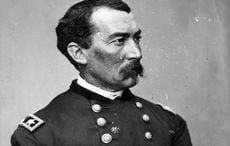When discussing the Irish Famine, we curse the landlords and the British for hardly raising a finger to help the destitute and dying.
However, scholar Michael Foley, in a Famine journal published in November by Cork University Press and Quinnipiac University, has traced an interview from The Illustrated London News with a woman named Bridget O’Donnel who was a poor Famine victim from Co. Clare. Her harrowing story appeared in the December 22, 1849 issue.
A gaunt O’Donnel, holding two starving children, became an iconic illustration of the times and the image has become world famous. Like the little 3-year old dead boy who washed up on the Turkish coast recently, she exemplifies the suffering and horror that her people endured.
Illustrated articles were brand new at the time which made the interview with her even more important.
Evicted from her home by neighbors while pregnant and sick with fever, O’Donnel endured losing her child at birth and watching her 13-year-old son starve to death. As they suffered from starvation, the corn her family had grown and harvested was carted off to be sold by heartless neighbors. Her fate after the interview remains unknown.
Read more: Amazing discovery about woman in this iconic image from Great Hunger
But what O’Donnel told The Illustrated London News disturbs our long held views about who was most vicious during the Famine. Here is what she said:
“I lived,” she said, “on the lands of Gurranenatuoha. My husband held four acres and a half of land, and three acres of bog land; our yearly rent was £7 4s.; we were put out last November; he owed some rent. We got 30 stone of oats from Mr. Marcus Keane, for seed. My husband gave some writing for it: he was paid for it. He paid 10 shillings or reaping the corn.
“As soon as it was stacked, one ‘Blake’ on the farm, who was put to watch it, took it away to his own haggard and kept it there for a fortnight by Dan Sheedey's orders. They then thrashed it in Frank Lellis’s barn. I was at this time lying in fever.
“Dan Sheedey and five or six men came to tumble my house; they wanted me to give possession. I said that I would not; I had fever, and was within two months of my down-lying (confinement); they commenced knocking down the house, and had half of it knocked down when two neighbors, women, Nell Spellesley and Kate How, carried me out.
“I had the priest and doctor to attend me shortly after. Father Meehan anointed me. I was carried into a cabin, and lay there for eight days, when I had the creature (the child) born dead. I lay for three weeks after that. The whole of my family got the fever, and one boy 13-years-old died with want and with hunger while we were lying sick.
“Dan Sheedey and Blake took the corn into Kilrush, and sold it. I don’t know what they got for it. I had not a bit for my children to eat when they took it from me.”
What we see here is the vicious machinations of an Irish neighbor intent on driving a heavily pregnant woman out of her home even as her 13-year-old starved to death. It seems Sheedey arranged for her meager store of corn to be stolen, trashed in another neighbor’s barn and then sold in Kilrush. After that the neighbors tried to evict her to grab her land.
Even allowing for Famine times, it seemed such a remorseless and cruel thing to be doing. Heavily pregnant, her son dead, she tried to fight them off and gave birth in the half ruined house to a dead baby.
It seems even the local priest Father Meehan or the local doctor could not stop her eviction.
Bridget O’Donnel’s story is a different tale than the one we are used to. It was her Irish neighbors who did the worst damage to a woman all alone with young children and desperately ill.
It is wonderful that she speaks down through the years to address those who took everything from her.
We know not her fate, but we can guess it did not end well. Husband gone, 13-year-old son dead, desperately weak after giving birth to a dead child and with two starving children, it is very hard to see how she survived.
Her words, however, live on and speak across the centuries to us and the cowardly neighbors will be forever damned by them.
Read more: Why the real story of the Ireland's Great Hunger is not taught in U.S. schools
* Originally published in 2015.




Comments